Keywords |
| Active object-relational database management systems, ECA-rules, triggers, rule scheduling, rule
conflict |
INTRODUCTION |
| Active ORDBMS extend the normal functionality of ORDBMS with support to monitor the changes in the database
state and react to specific situations (events) automatically without user intervention. The reactive behaviour of active
ORDBMS is represented by triggers in the form of Event-Condition-Action (ECA) rule paradigm [1]. In order to
support the active functionality for monitoring and reacting to specific event occurrences, each active object-relational
database system has a rule definition language that is used to define the specification of ECA rules for describing
reactive behaviour generally referred to as the knowledge model and also possess an execution model that determines
the rule processing at runtime [2]. The knowledge model describes the structural characteristics of rules such as types
of events, context of conditions and actions, where as the execution model captures the runtime characteristics of the
rule processing. The reactive behaviour of active ORDBMS depends on the rule execution model and hence rule
execution semantics is an important aspect of active ORDBMS. In active ORDBMS, rule processing occurs when a
database state is changed by the execution of update, insert, and delete operations requested by the user application. |
| Active ORDBMS react to the occurrence of predefined events automatically by the definition of ECA rules. In a
generic active rule system, an event occurrence causes multiple rules to be triggered at the same time and hence their
execution needs to be consistent which is an important issue faced by the rule execution model of active ORDBMS and
this issue is known as trigger rule conflict. In order to solve trigger rule conflict issue, the rule execution model of
active ORDBMS provides a mechanism known as rule scheduling which supports the execution of multiple triggered
rules based on the two aspects: (i) the ordering of next rule to be fired is based on the conflict resolution policies such
as dynamic and static priority schemes and (ii) the number of rules to be fired for execution by using either sequential
or concurrent execution of all rules [2]. To maintain the deterministic property of the active rule processing, the
database management system has to provide rule scheduling [3]. |
| In this research work, section 2 presents the review of related work in rule scheduling. Section 3 specifies the
mechanism of rule scheduling. Section 4 describes the development of rule scheduler to handle trigger rule conflicts in
rule processing of an active ORDBMS. Section 5 shows the performance results of the developed rule scheduler for
executing multiple triggered rules. The key aspect of this research is to reduce the over all execution time of rules by supporting both concurrent and sequential rule execution for improving the performance of trigger processing in active
ORDBMS. |
RELATED WORK |
| Management of multiple triggered rules is a major scheduling issue in active database systems (ADBS).
Kerdprasop et al., [3] proposed rule scheduling based on the knowledge induced from the database state modification.
In [4] rule scheduling has been introduced based on the estimation of rule execution probability using learning
automata. Jin et al., [5] introduced concurrent rule scheduling using the logic of generated priority graphs. The research
works in ADBS integrated with relational database systems support rule scheduling based on static priorities using
numeric or relative scheme with sequential execution of all rules [2, 4]. In active ORDBMS standard (SQL3), multiple
rule triggering has been performed by the rule scheduler based on the system defined priority with sequential execution
of all rules [6, 2]. However, modern large scale applications demand support for handling complex data, detecting
events come from different sources and the evaluation of conditions and the execution of actions can be performed on
different situations, an enhanced rule scheduler is required to improve the ordering and execution of multiple triggered
rules in active ORDBMS [7, 8, 9]. Thus in the presence of multiple triggered rules, the rule scheduler should support
both sequential and concurrent rule execution based on user-defined priority scheme is an important research work in
active ORDBMS. |
RULE SCHEDULING MECHANISM |
| In active ORDBMS, an application defines rules and specifies the desired behaviour of each rule in the form of
ECA. Once a set of rules is defined, the active database system monitors the occurrences of events pre-specified by
ECA rules. Whenever a specified event occurrence can cause the triggering of multiple rules at the same time, the rule
conflict occurs and the rule scheduler determines the order and the execution semantics of rule execution. When
multiple rules are triggered at a time, the order of execution among the rules can be determined by assigning priorities
and the execution of rules is based on their coupling modes. |
| A rule scheduling mechanism has been designed to handle trigger rule conflicts in active object-relational database
systems [10]. In this work, the two important factors such as the priority and coupling mode are considered for
designing the rule scheduler. The rule scheduler uses the user-defined priority scheme for ordering the rules. Rules can
be placed in order using a numerical scheme in which each rule is given an absolute value. User-defined priority
scheme provides better opportunity to order the rules based on the requirement of the application than system defined
priority. Since user-defined priorities are dynamic – rules can be added, changed and dropped at any time during the
existence of rule set. |
| The coupling mode specifies the time when a triggered transaction is executed with respect to the triggering
transaction or an event. If the rule is in immediate coupling mode, then the triggered transaction can execute
immediately and the triggering transaction has to wait until the completion of the triggered transaction. However if the
rule is in deferred mode, then triggering (main) transaction can continue and the triggered rule has to wait for the
completion of the triggering transaction. The rule scheduler has been designed to execute the multiple triggered rules
concurrently with the same priority and sequentially with different priorities based on the coupling mode. This work
uses the integrated architectural design to entail active behaviour into ORDBMS and the major component extensions
incorporated for providing active capability include the rule manager and rule scheduler related with the underlying
database management systems transaction manager. |
DEVELOPMENT OF RULE SCHEDULER |
| The rule scheduler is responsible for handling trigger rule conflicts when multiple rules are triggered at the same
time by an event. The rule scheduler has been developed by introducing the design of rule scheduling mechanism [10].
The rule scheduler prototype has been developed in two phases such as rule maintenance and rule processing. The rule
maintenance phase is used to define and maintain the specification of ECA rules for applications that require automatic
monitoring and reactions. Based on the requirement of an application system, the user specifies the rule definition
associated with event, condition and action, priority and the coupling mode as shown in Fig. 1. The rule processing
phase is used to show the functions of the rule scheduler that includes the ordering of rules based on user-defined
priority and the execution of rules with sequential and concurrent based on the immediate and deferred coupling modes
as shown in Fig. 2. The developed rule scheduler supports concurrent execution of rules with equal priorities and sequential execution of rules with different priorities, whenever a primitive event occurrence causes the triggering of
multiple rules at the same time. |
| The developed rule scheduler implements the C# multi-threading system for concurrent rule execution. The
important feature required by the scheduler is the ability to start and stop threads (rules) and this feature can be
achieved using thread functions. Each rule triggered during the execution of an application has to be a separate thread.
The execution of the thread is controlled by the scheduler depending on its priority and coupling mode. Whenever an
event triggering multiple rules with different priorities and coupling modes at the same time the various steps taken into
account are: The scheduler segregate the rules based on their coupling modes because immediate rule has to be
executed first even if a deferred rule has a higher priority. After the segregation, the scheduler has to suspend the main
(triggering) transaction. The scheduler can use the thread functions to suspend and continue rule processing. Thread
execution can be controlled after the creation of the thread and the various parameters that are to be known when
forming a thread to execute a rule are parent rule-id, priority and coupling mode. |
| The data structure named as process-rule-list is used to store the information includes the parent rule-id, priority and
coupling mode that is obtained when creating a thread for that rule. The rule-id of the rule is the thread id’s that are
obtained when creating a thread for that rule. The system assigns a unique-id to every thread it creates. Rules triggered
in the top-level transaction have the parent-id as 1. The priority and coupling mode can be obtained from the rule as
they are provided during rule creation. The application proceeds normally until it researches a procedure call that is
detected by an event and the overview of thread implementation is shown in Fig. 3. When an event is signaled, the
event detector detects which of the primitive event is occurred. Once an event is detected, a set of rules triggered are as
shown in the rule processing stage of Fig. 3. Every event detected in an application is wrapped with a Notify call that
creates a thread for each rule. For each qualifying rules, a separate thread is created and inserted into the rule list. Then
the Notify calls the function Process_imm-rules. |
| The function Process_imm-rules activates the scheduler and the rules are executed based on the priorities and
coupling modes. The function then looks at the process-rule-list and finds the triggered rules in the immediate coupling
mode based on the current thread-id. When the scheduler activates a rule, it wakes up the thread associated with the
thread-id in the process-rule-list. Then the thread checks the condition of the rule and executes the action associated
with the rule based on the priority if the condition evaluates to true. The scheduler is activated and the function
Process_imm-rules waits until all the triggered rules in the immediate coupling mode complete its execution. |
| In order to process deferred rules, the primitive event Notify_def-rules is used and this triggers a pre-defined rule
immediately and the action part of this rule calls the function Process_def-rules which indicate the scheduler to process
deferred rules. The Notify_def-rules event waits for the completion of all deferred rules and a flag variable is used to
block the parent transaction from commit until all the rules spawned complete its execution. When a rule thread completes its execution the corresponding rule is removed from the process-rule-list and at the end of the top-level
transaction, the rule process-rule-list is empty. The transaction commits and the application continues further when the
process-rule-list has no more rules to execute. |
| The psuedocode for rule scheduling and execution using threads and how the thread function packaged is shown in
Fig. 4. As detailed above, when a primitive event is signaled the event detector notifies the occurrence of the primitive
events and determine the triggered rules for execution. Whenever a rule is triggered in immediate coupling mode, a
thread is created with the thread-id and transforms the function which checks the condition and performs the action to a
thread with the appropriate priority. Once all the immediate rules are in the form of threads, the main application is
suspended and the rule scheduler is activated. After the execution of all triggered rules, the triggering transaction
resumed execution. Since a deferred rule is executed only when Notify_def-rules primitive event is signaled and hence
deferred rules treated in the same way as an immediate rule. |
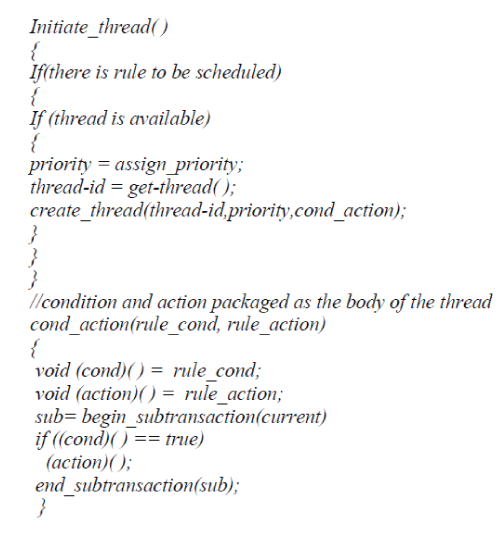 |
PERFORMANCE AND RESULT ANALYSIS |
| In advanced application systems, an event occurrence causes the triggering of multiple rules at the same time, the
rule scheduler need to support sequential,concurrent and the both execution of rules based on user-defined priority
scheme is a required research work. To evlauate the performance of the developed rule scheduler that supports both
concurrent and sequential rule execution, the thread execution time for sequential, concurrent and both rule executions
have been compared and is shown in Table 1. The values shown in Table 1 are plotted on bar chart (Fig. 5) and the
results show that the developed scheduler takes less execution time for executing rules from 3 to 7 concurrently than
the time taken for executing rules from 3 to 7 sequentially and both rule execution. Also from Table 1, it is found that
the developed scheduler takes less execution time for executing rules from 3 to 7 in both rule executions than the time
taken for executing rules only sequential. |
| The Fig. 5 reveals that the developed scheduler improves the system performance by reducing the over all execution
time of rules by supporting concurrent and both rule execution than the conventional rule scheduler that supports only
sequential rule execution for trigger processing in active ORDBMS. The developed rule scheduler prototype system
provides the facility to define and maintain the rule system and supports both concurrent and sequential execution of rules based on user-defined prioity scheme for handling trigger rule conflicts, whenever a primitive event occurrence
causes the triggering of mutiple rules at the same time in advanced applications. |
CONCLUSION |
| Active ORDBMS monitor the occurrences of events that defined over database state and react automatically by the
pre-specified definition of ECA rules, when the state of the database changes relevant to the application system.
Whenever a specified event occurrence causes the triggering of multiple rules at the same time, the rule scheduler is
responsible for handling trigger rule conflicts that determines the order and the execution semantics of rules. In active
ORDBMS standard, rule scheduler has been developed to execute the multiple triggered rules sequentially based on
system defined priority. This research work develops an effective rule scheduling mechanism for active ORDBMS
which supports the execution of multiple triggered rules both sequential and concurrent based on user-defined priority
scheme. In this research work, the developed rule scheduler improves the performance of trigger processing by
reducing the over all execution time of rules by supporting both concurrent and sequential rule execution than the rule
scheduler that supports only sequential rule execution to handle trigger rule conflicts in active ordbms. |
| |
Tables at a glance |
 |
| Table 1 |
|
| |
Figures at a glance |
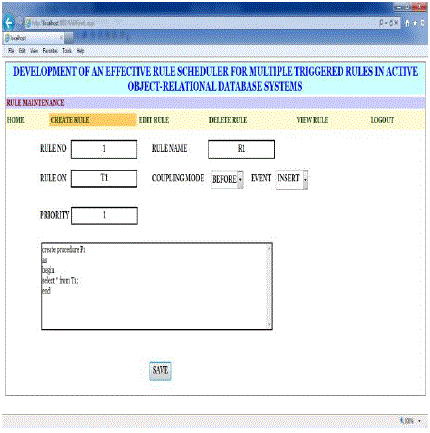 |
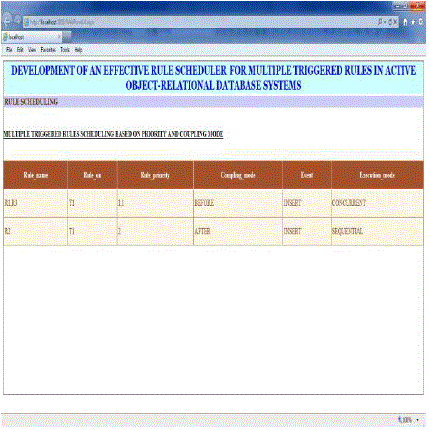 |
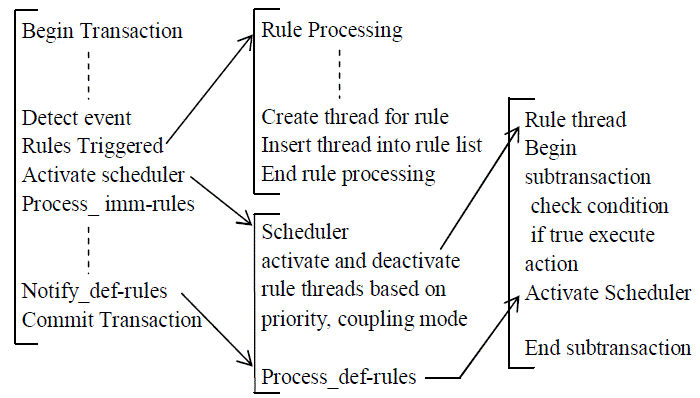 |
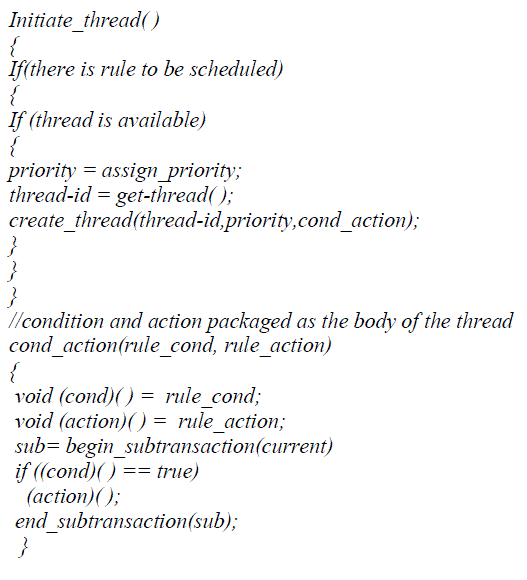 |
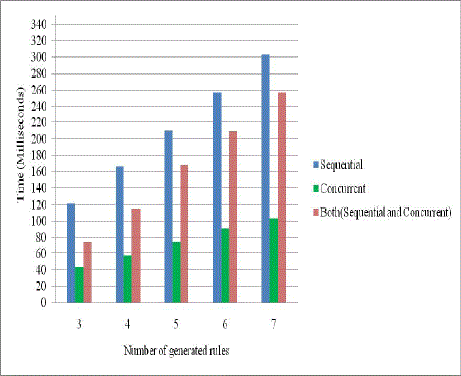 |
| Figure 1 |
Figure 2 |
Figure 3 |
Figure 4 |
Figure 5 |
|
| |
References |
- A. Eisenberg, J. Melton, “SQL: 1999, formerly known as SQL3”, SIGMOD Record, Vol. 28, No.1, pp. 131-138, 1999.
- N.W. Paton, O. Diaz, “Active database systems”, ACM Computing Surveys, Vol. 31, Issue 1, pp.63-103, 1999.
- N. Kerdprasop, S. Pilabutr, K. Kerdprasop, “Improving Medical Database Consistency with Induced Trigger Rules”, New Advances inIntelligent Decision Technologies, Studies in Computational intelligence, Vol. 199, pp. 265âÃâ¬Ãâ274, Springer-Verlag, 2009.
- A.Rasoolzadegan, M.R. Meybodi, “Rule Scheduling in Active Database Using Learning Automata”, International Journal of Computer,Mathematical Sciences and Applications, Vol. 4, No. 1-2, pp. 239-262, ISSN: 0973-6786, Serials Publications, Jan-June 2010.
- Y. Jin, S.D. Urban, S.W. Dietrich, “A concurrent rule scheduling algorithm for active rules”, Data & Knowledge Engineering, Elsevier,Vol. 60, Issue 3, pp.530-546, 2007.
- Kulkarni, N. Mattos, R. Cochrane, “Active database features in sql-3”, In N. Paton (ed.), Active Rules in Database Systems, pp.197-219,Springer-Verlag, 1999.
- K. Dube, B. Wu, “A generic approach to computer-based Clinical Practice Guideline management using the ECA Rule paradigm andactive databases”, International Journal of Technology Management (IJTM), Vol.47, Nos. 1/2/3,pp.75-95, 2009.
- M. Schaff, A. Koschel, S.G. Grivas, I. Astrova, “An Active DBMS Style Activity Service for Cloud Environments”, The InternationalConference on Cloud Computing, GRIDs, and Virtualization, pp.80-85, IARIA, ISBN: 978-1-61208-106-9, 2010.
- Wai Yin Mok, C.F. Hickman, C.D. Allport, “Implementing Business Processes: A Database Trigger Approach”, International Journal ofKnowledge-Based Organizations, Vol. 3, No.2, pp.36-55, Apr-June 2013.
- S. Meenakshi, V. Thiagarasu, “Design of Rule Scheduler for Trigger Rule Conflict in Active Object-Relational Database Systems”,International Journal of Emerging Technologies in Computational and Applied Sciences, Vol. 7, No.2, pp.185-189, ISSN 2279-0055,February 2014.
- F. Najafabadi, H. Reza, A.H. Navin, “Rule scheduling methods in active database systems: A brief survey”, In Proceedings of the 6thInternational Conference on Application of Information and Communication Technologies, IEEE, pp.1-5, 2012.
- S. Wasserkrug, A. Gal, O. Etzion, Y. Turchin, “Efficient Processing of Uncertain Events in Rule-Based Systems”, IEEE Transactions onKnowledge and Data Engineering , Vol. 24, No.1, pp.45-58, 2012.
|
|